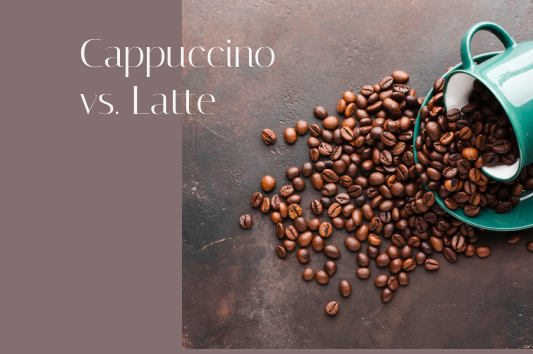Cappuccino vs. Latte: What’s the Difference?

When it comes to coffee drinks, cappuccinos and lattes are two popular choices that often leave people wondering about their differences. If you’ve ever found yourself unsure about which one to order or make at home, you’re not alone. The good news is that understanding the distinctions between these two beloved beverages is simpler than it may seem.
Both cappuccinos and lattes start with a base of espresso, a concentrated coffee brewed by forcing hot water through finely ground coffee beans. However, the key difference lies in the preparation and composition of these drinks.
In this article, we will explore the definitions and origins of cappuccinos and lattes. We will discuss their unique characteristics, ratios of espresso to milk, and variations in taste and texture. By the end, you’ll have a clear understanding of these coffee delights, enabling you to make an informed choice based on your preferences.

Key Takeaways:
- Cappuccinos and lattes are both coffee drinks made with espresso as a base.
- A cappuccino typically has equal parts of espresso, steamed milk, and frothed milk, creating a layered and balanced taste.
- A latte features more steamed milk and less frothed milk, resulting in a creamier and smoother texture.
- The ratio of espresso to milk is different in cappuccinos and lattes, leading to variations in taste and strength.
- Personal preferences, such as desired taste, texture, and caffeine content, play a role in choosing between a cappuccino and a latte.
What exactly is a cappuccino?
A cappuccino is a popular Italian coffee drink that is beloved by coffee enthusiasts around the world. It is made by combining espresso with steamed milk and a layer of frothed milk on top.
What ingredients are typically used in a cappuccino?
A traditional cappuccino consists of three main ingredients:
- Espresso: This strong and flavorful coffee concentrate forms the base of a cappuccino.
- Steamed Milk: The milk is heated and frothed to create a creamy and velvety texture.
- Frothed Milk: A layer of silky frothed milk is added on top of the steamed milk for an aesthetically pleasing presentation.
How is a cappuccino traditionally prepared?
The preparation of a cappuccino follows a specific method:
- Brew a shot of espresso using an espresso machine.
- Steam and froth milk using the steam wand of the espresso machine until it reaches the desired temperature and texture.
- Pour the steamed milk over the espresso shot, holding back the frothed milk with a spoon.
- Spoon the frothed milk on top of the steamed milk, creating a layer of foam.
What are the taste and texture characteristics of a cappuccino?
A well-made cappuccino offers a perfect balance of flavors and textures:
- Taste: Cappuccinos have a rich and bold flavor, with the taste of espresso shining through. The addition of the steamed milk adds a subtle sweetness and creaminess.
- Texture: The texture of a cappuccino is velvety and smooth. The steamed milk gives it a creamy mouthfeel, while the frothed milk creates a light and airy foam on top.
Whether you enjoy it as your morning pick-me-up or as an indulgent treat, a cappuccino is a classic coffee beverage that offers a delightful combination of flavors and textures.
What defines a latte?
A latte, also known as caffè latte, is a popular coffee drink that originated in Italy. It is made with a combination of espresso and steamed milk, creating a creamy and comforting beverage. The word “latte” means milk in Italian, highlighting the importance of milk in this beloved coffee concoction.
What ingredients are typically used in a latte?
A latte typically consists of the following ingredients:
- Espresso: A strong and concentrated coffee brewed using pressure.
- Steamed Milk: Whole milk is commonly used to create the characteristic velvety texture.

How is a latte prepared?
The preparation of a latte involves several steps:
- Brewing Espresso: Start by preparing a shot of espresso using an espresso machine or a stovetop moka pot.
- Steaming Milk: While the espresso is brewing, steam the milk using a steam wand or a milk frother. The goal is to achieve a smooth and creamy texture.
- Pouring Milk: Pour the steamed milk over the espresso, aiming for a 1:3 ratio of espresso to milk. The milk is poured slowly to create latte art, if desired.
The result is a beautiful and delicious latte with rich flavors and a creamy mouthfeel. It can be enjoyed as is or with added flavors such as vanilla, caramel, or chocolate.
What are the key differences between a cappuccino and a latte?
In this section, we will compare and contrast the cappuccino and latte. We will discuss the differences in the ratio of espresso to milk, as well as any variations in serving size between the two drinks.
How does the ratio of espresso to milk differ between a cappuccino and a latte?
The ratio of espresso to milk is one of the notable differences between a cappuccino and a latte. A cappuccino typically has a balanced ratio, with equal parts of espresso, steamed milk, and foam. This results in a strong espresso flavor combined with a creamy and frothy texture. On the other hand, a latte has a higher proportion of milk compared to espresso. It is characterized by a richer and smoother taste, as it contains more steamed milk and less foam than a cappuccino.
Are there differences in serving size between cappuccinos and lattes?
Another difference between cappuccinos and lattes lies in their serving sizes. Cappuccinos are typically served in smaller cups with a total volume of around 6 ounces. This smaller serving size allows for a stronger and more concentrated flavor. In contrast, lattes are served in larger cups, usually ranging from 8 to 12 ounces. The larger serving size of a latte provides a more diluted taste, making it a milder option compared to a cappuccino.
How to choose between a cappuccino and a latte?
When it comes to choosing between a cappuccino and a latte, there are a few factors to consider. Your personal preferences, including taste and texture preferences, play a crucial role in making the right decision. Additionally, understanding the differences in caffeine content and cultural associations of these drinks can further guide your choice.
Considerations Based on Personal Preferences
When deciding between a cappuccino and a latte, it’s essential to consider your personal taste and texture preferences. Here are some key points to keep in mind:
- Strength: If you prefer a stronger coffee flavor, opting for a cappuccino might be the right choice. Cappuccinos have a higher proportion of espresso, resulting in a bolder taste.
- Texture: Cappuccinos are known for their velvety foam layer, which adds a creamy texture to the drink. If you enjoy the mouthfeel of foam, a cappuccino might be more appealing to you. On the other hand, lattes have a smoother and more milk-forward texture.
- Milk-to-Coffee Ratio: The balance of milk and coffee is another aspect to consider. Cappuccinos have equal parts espresso, steamed milk, and foam, while lattes usually have more steamed milk and less foam.
Caffeine Content and Cultural Associations
While personal preferences guide the decision-making process, it’s also worth considering the caffeine content and cultural associations of cappuccinos and lattes:
Caffeine Content: Since both cappuccinos and lattes contain espresso shots, their caffeine content is relatively similar. However, due to the higher proportion of milk in lattes, they may have slightly less caffeine compared to cappuccinos.
Cultural Associations: Cappuccinos and lattes have different cultural associations. Cappuccinos are often associated with Italian coffee culture and are commonly enjoyed as a morning beverage. Lattes, on the other hand, have gained popularity in specialty coffee shops and are often seen as a versatile option that can be enjoyed throughout the day.
By taking into account your personal preferences and considering the differences in caffeine content and cultural associations, you can make an informed choice between a cappuccino and a latte that suits your tastes and preferences.

What are some common mistakes people make when ordering cappuccino or lattes?
When it comes to ordering cappuccinos and lattes, there are a few common mistakes that people often make. By avoiding these pitfalls, you can ensure that you have a satisfying coffee experience. Here are some key mistakes to watch out for:
1. Misunderstanding the espresso-to-milk ratio: One of the most common mistakes is not understanding the difference in the amount of espresso and milk in cappuccinos and lattes. A cappuccino has equal parts espresso, steamed milk, and milk foam, while a latte has more steamed milk and less foam.
2. Not specifying desired milk: Another mistake is not specifying the type of milk you prefer. Whether you prefer whole milk, skim milk, almond milk, or soy milk, be sure to communicate your preference to the barista when ordering.
3. Overcomplicating the order: Sometimes people make the mistake of overcomplicating their order by adding too many flavors, syrups, or toppings. While customization is great, keep in mind that simplicity can often enhance the flavor and enjoyment of a well-prepared cappuccino or latte.
4. Ordering the wrong size: Many coffee shops offer different sizes for cappuccinos and lattes. It’s important to be aware of the serving sizes and choose one that aligns with your preference. Ordering the wrong size can affect the balance of flavors and textures in your drink.
5. Rushing the order: Lastly, one of the most significant mistakes is rushing the order. Take a few moments to consider your options and communicate clearly with the barista. This will help ensure that your cappuccino or latte is made exactly to your liking.
By being aware of these common mistakes and following these tips, you can enjoy a perfectly crafted cappuccino or latte that will satisfy your coffee cravings.
What are the key differences between cappuccinos and lattes?
Understanding the distinctions between cappuccinos and lattes is essential for coffee enthusiasts seeking their ideal brew. While both beverages consist of espresso and milk, the key differences lie in the ratio of ingredients and the overall flavor profile.
A cappuccino is traditionally made by combining equal parts espresso, steamed milk, and milk foam. This balanced composition results in a rich, creamy texture with a strong espresso flavor. In contrast, a latte features more milk and less foam, resulting in a smoother, milkier taste. The espresso-to-milk ratio in a latte leans more towards the milk component, creating a milder coffee experience.
Another notable distinction is the serving size. Cappuccinos are generally served in smaller quantities, ranging from 6 to 8 ounces, while lattes are typically larger, with serving sizes ranging from 10 to 12 ounces. This variation in size impacts the overall strength and intensity of the coffee taste, allowing individuals to choose based on their preferences.
In summary, cappuccinos and lattes differ in the ratio of espresso to milk, resulting in distinctive tastes and textures. Cappuccinos offer a bolder and more balanced espresso flavor, while lattes provide a creamier, less pronounced coffee profile. The difference in serving size also contributes to the overall coffee experience. Whether you prefer a strong and robust brew or a smoother, milk-dominant drink, understanding these key differences will help you choose the perfect coffee beverage to suit your taste buds.

